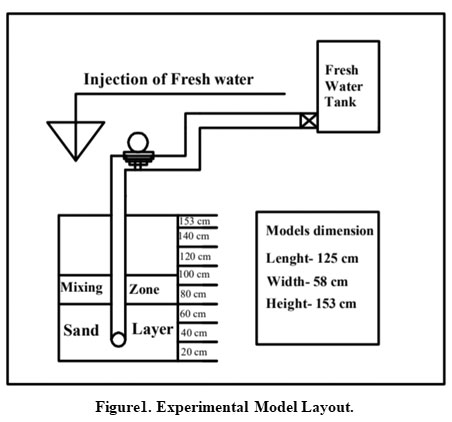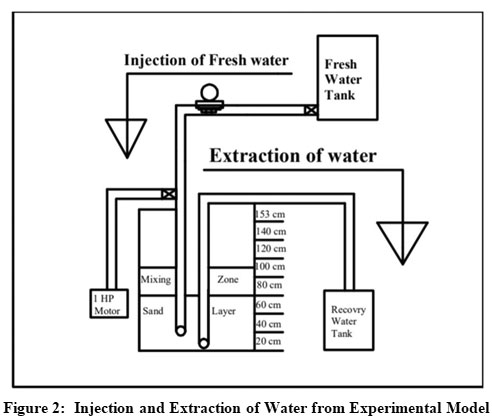Recovery Efficiency of an Aquifer Storage and Recovery (ASR) Experiment from Saline Aquifer under Controlled Conditions
DOI: http://dx.doi.org/10.12944/CWE.15.3.07
Present work was carried out in an experimental model developed at the institute, sand was used as prototype artificial aquifer and was saturated with highly saline water having Electrical Conductivity (EC) equal to 8500 µS/cm. Fresh water with average EC = 467.50 µS/cm and temperature = 25oC was injected in the known amount in the saline water and this water was extracted at a fixed time interval of 1, 1.5, 2, 2.5, 3, 3.5, 4, 4, 8 24, 48, 72, 96, 120, 144, and 168 hours in a cumulative time of 735.30 hours with average recovery efficiency of 63%. Recovered water has salinity equal to or less than 1000 µS/cm. Although, this experiment was carried out at a small scale but this can be tried at a bigger scale for skillfully managing the surface or reclaimed water in problematic areas where demand exceeds the supply.
Copy the following to cite this article:
Kaushal A. A, Krishan G, Pandey G. Recovery Efficiency of an Aquifer Storage and Recovery (ASR) Experiment from Saline Aquifer under Controlled Conditions Curr World Environ 2020; 15(3). DOI:http://dx.doi.org/10.12944/CWE.15.3.07
Copy the following to cite this URL:
Kaushal A. A, Krishan G, Pandey G. Recovery Efficiency of an Aquifer Storage and Recovery (ASR) Experiment from Saline Aquifer under Controlled Conditions Curr World Environ 2020; 15(3). Available from: https://bit.ly/2HO2CAu
Download article (pdf)
Citation Manager
Publish History
Select type of program for download
| Endnote EndNote format (Mac & Win) | |
| Reference Manager Ris format (Win only) | |
| Procite Ris format (Win only) | |
| Medlars Format | |
| RefWorks Format RefWorks format (Mac & Win) | |
| BibTex Format BibTex format (Mac & Win) |
Article Publishing History
| Received: | 08-06-2020 |
|---|---|
| Accepted: | 25-10-2020 |
| Reviewed by: | 
 Dr. B. Yadav
Dr. B. Yadav
|
| Second Review by: |

 Dr. Rahul Kumar Jaiswal
Dr. Rahul Kumar Jaiswal
|
| Final Approval by: | Dr. Umesh Kulshrestha |
Introduction
Material and Methods
This experiment was conducted in an experimental model having dimensions: length 125 cm, width 58 cm, height 153 cm (Fig. 1). Two Self-Prime Regenerative Pumps were used for injecting and extracting water. For conducting the experiment, saline solution of concentration 8500 μs/cm was prepared from sodium chloride (NaCl) salt. EC and temperature were measured with EC meter (Eutech). 100 litres of this salt solution with temperature 25°C was inserted in sand of size ranging between 0.075 to 1.00 mm till saturation. Sand is kept in an experiment model for prototype artificial aquifer. The sand with volume of 0.479 m3 was filled to mid-section upto height of 66 cm. After saturating the sand with saline water, fresh water was injected and simultaneously recovered at a certain time interval of 1, 1.5, 2, 2.5, 3, 3.5, 4, 4, 8 24, 48, 72, 96, 120, 144, and 168 hours. The cumulative hours are 768.30.
 |
Figure 1: Experimental Model Layout. |
 |
Figure 2: Injection and Extraction of Water from Experimental Model |
The water was pumped out through the recovery pipe and stored in the cylindrical tank having dimensions (length, bredth, width: 43cm*48cm*24 cm). The recovered water sample was taken in the 50 ml beaker for recording temperature and EC. Water is pumped from the recovery pipe and there are chances of mixing between the freshwater pocket and saline water in the sand due to the suction pressure. Performance of this ASR experiment was quantified by calculating Recovery Efficiency (RE) as volume recovered/volume injected * 100.
Results and Discussion
The electrical conductivity (EC) and temperature of saline water was maintained 8500 µS/cm and 25oC, respectively for the experiment period. Statistical summary of measured parameters, recovered volume and efficiency is given in Table 1. EC of injected freshwater was found in the range of 320– 580 µS/cm with an average value of 467.50 µS/cm and temperature ranged from 21.1°C – 31.7°C with an average value of 24.91°C. EC of recovered was found in the range of 830– 7200 µS/cm with an average value of 1664.05 µS/cm and temperature ranged from 21.1°C – 31.7°C with average value of 24.91°C. An average of 60 litres freshwater was injected and a volume of recovered water ranged between 22 to 55 litres with an average value of 36.88 litres. Recovery efficiency (RE) ranged from 40 to 90.42 % with an average of 62.75%. Generally, RE is always less than 100 and mechanisms involved are mixing in the subsurface - densityâ€gradient driven convection, dispersion and diffusion, rateâ€limited mass transfers etc.13,14 Kimbler et al (1975)13 also stressed on that the RE can be increased but with more contaminations.
Table 1: Statistical Summary of Measured Parameters, Volume of Water Injected/Recovered and Recovery Efficiency
|
Temperature (oC) |
EC (µS/cm) |
Volume (litres) |
Cumulative Time (Hrs.) |
Recovery efficiency (%) |
|||
|
Fresh water |
Recovered water |
Fresh water |
Recovered water |
Injected |
Recovered |
||
|
21.10 |
21.90 |
320.00 |
830.00 |
40.00 |
22.00 |
1.00 |
40.00 |
|
31.70 |
29.80 |
580.00 |
7200.00 |
70.00 |
55.00 |
735.30 |
90.42 |
|
24.91 |
24.96 |
467.50 |
1664.05 |
60.00 |
36.88 |
90.92 |
62.75 |
|
2.56 |
1.72 |
35.97 |
1449.54 |
6.31 |
7.79 |
161.09 |
12.47 |
 |
Figure 3: Variation Of EC and Temperature During 735.30 Hours of Experiment Click here to view figure. |
Variation of EC and temperature with the time is shown in figure 2. It is evident from figure 3 that EC of the recovered water was recorded below 1000 µS/cm after 29 hours. This might be due to mixing reaction of saline and fresh water and EC found almost constant after 30 hour to 735.30 hours. The resultant EC suggests that the concentration of recovered water is less than 12% of saline water concentrations which are in agreement with Kimbler et al13 where the EC of recovered water should be equal to or less than 10%.
Conclusion
Experiment was conducted under controlled conditions to assess recovery rates from saline aquifer. Recovery efficiency of 63% was found with EC of recovered water equal to or less than 1000 µS/cm after 29 hours of experiment. Aquifer storage and recovery is found to be a significant, suitable tool for water resource management and might act as a hydraulic barrier in saline environments. There is a need to test the experiment under field conditions on a bigger scale to test its fresh water yielding potential.
Acknowledgement
Funding received from National Hydrology Project is duly acknowledged.
Funding received from National Hydrology Project
Conflict of Interest
The authors do not have any conflict of interest.
References
- MacDonald, Alan, Bonsor, Helen, Ahmed, Kazi, Burgess, William, Basharat, Muhammad, Calow, Roger, Dixit, Ajaya, Foster, Stephen, Krishan, Gopal , Lapworth, Daniel , Lark, Murray, Moench, Marcus, Mukherjee, Abhijit, Rao, M.S., Shamsudduha, Mohammad, Smith, Linda, Taylor, Richard, Tucker, Josephine, Steenbergen Frank van, Yadav, Shobha. 2016. Groundwater depletion and quality in the Indoâ€Gangetic Basin mapped from in situ observations. Nature Geosciences. 9:762-766.
CrossRef - Bonsor HC, MacDonald AM, Ahmed KM, Burgess WG, Basharat M, Calow RC, Dixit A, Foster SSD, Gopal K, Lapworth D, Lark RM, Moench M, Mukherjee A, Rao MS, Shamsudduha M, Smith L, Taylor R, Tucker J, van Steenbergen F, Yadav SK. 2017. Hydrogeological typologies of the Indo-Gangetic basin alluvial aquifer, South Asia. Hydrogeology Journal. 25(5): 1377-1406.
CrossRef - Krishan G., Dasgupta P., and McKenzie, A. (2020) Understanding aquifer systems of Indian Sundarbans. Water Brief 11. The India-UK Water Centre. 31pp. Wallingford, UK and Pune, India
- National Institute of Hydrology, Roorkee (2019). Improving our understanding aquifer systems of Indian Sundarbans December 2019. The India-UK Water Centre; Centre for Ecology & Hydrology, Wallingford and Indian Institute of Tropical Meteorology, Pune.
- Krishan, Gopal. 2019. Groundwater Salinity. Curr World Environ 14(2):186-188.
CrossRef - Krishan, Gopal, Ghosh, N.C., Kumar, C.P., Sharma Mohan, Lalit, Yadav, Brijesh, Kansal, M.L., Singh, Surjeet, Verma, S.K., Prasad, Gokul. 2020. Understanding stable isotope systematics of salinity affected groundwater in Mewat, Haryana, India. J Earth Syst Sci 129, 109 (2020). https://doi.org/10.1007/s12040-020-1380-6.
CrossRef - Vandenbohede, A., E. Van Houtte, and L. Lebbe (2008), Study of the feasibility of an aquifer storage and recovery system in a deep aquifer in Belgium, Hydrolog. Sci. J., 53, 844– 856.
CrossRef - Krishan, G, Prasad, G, Anajli, Kumar, C.P., Patidar, N, Yadav, B, Kansal, M.L., Singh, S, Sharma LM, Bardley, A, Verma, S.K. 2020. Identifying the seasonal variability in source of groundwater salinization using deuterium excess- a case study from Mewat, Haryana, India. Journal of Hydrology- Regional Studies, 31: 100724 https://doi.org/10.1016/j.ejrh.2020.100724.
CrossRef - Krishan G., Dasgupta P., and McKenzie, A. (2020) Understanding aquifer systems of Indian Sundarbans. Water Brief 11. The India-UK Water Centre. 31pp. Wallingford, UK and Pune, India.
- National Institute of Hydrology, Roorkee (2019). Improving our understanding aquifer systems of Indian Sundarbans December 2019. The India-UK Water Centre; Centre for Ecology & Hydrology, Wallingford and Indian Institute of Tropical Meteorology, Pune
- Choi J., Skibniewski M., Shim Y-G. (2018). Economics of alternative resources with an emphasis on aquifer storage and recovery. Water Science & Technology: Water Supply, 18 February.
CrossRef - DEMEAU. (2014). Pre-requisites and design criteria for new MAR systems in compliance with EU WFD and GWD (including pretreatment).
- Kimbler, O. K., R. G. Kazmann, and W. R. Whitehead (1975), Cyclic Storage of Fresh Water in Saline Aquifers, 78 pp., Louisiana Water Resources Res. Inst. Bulletin 10, Baton Rouge, LA.
- Lu, C., P. Du, Y. Chen, and J. Luo (2011), Recovery efficiency of aquifer storage and recovery (ASR) with mass transfer limitation, Water Resour. Res., 47, W08529, doi:10.1029/2011WR010605.
CrossRef






